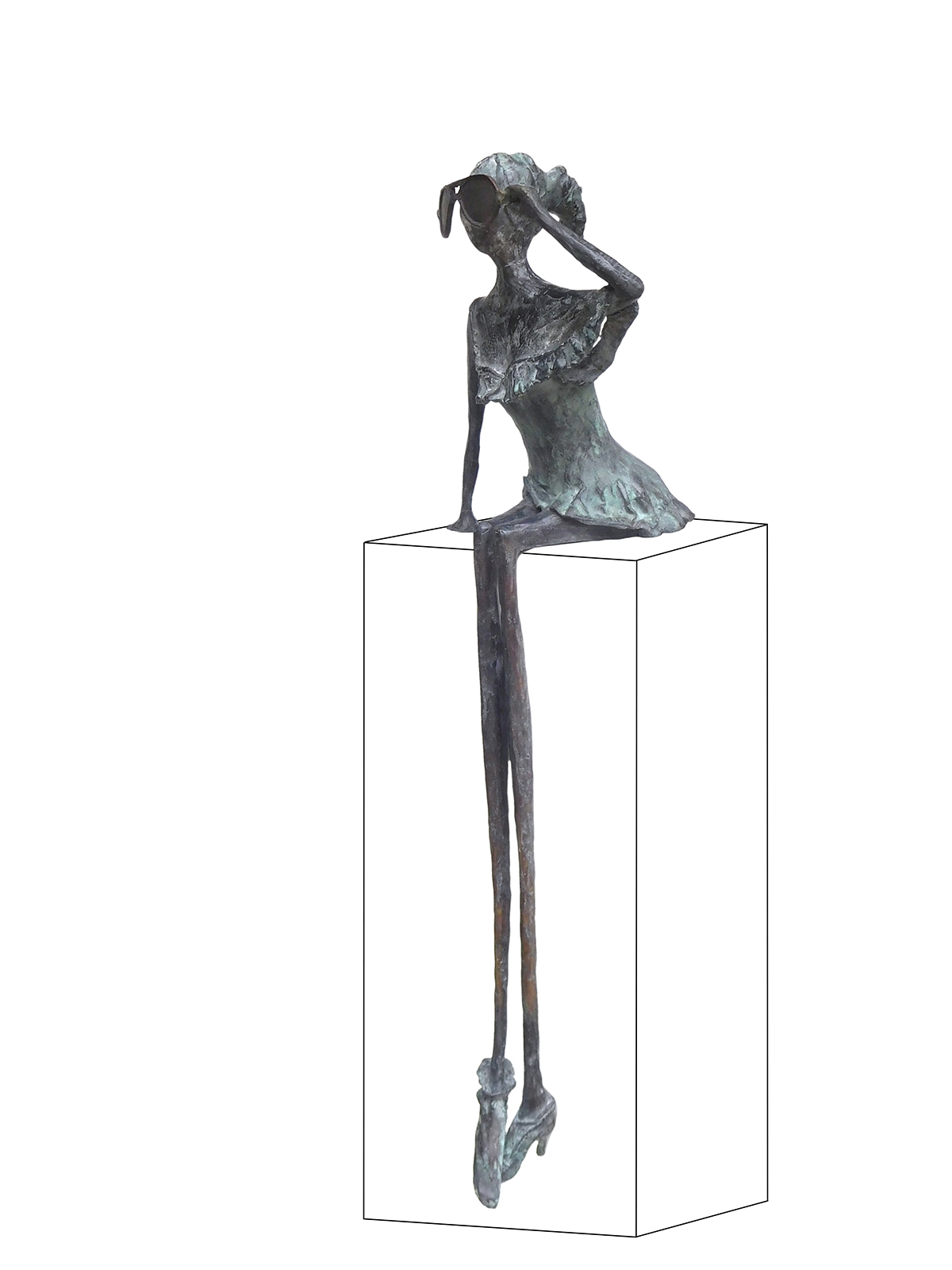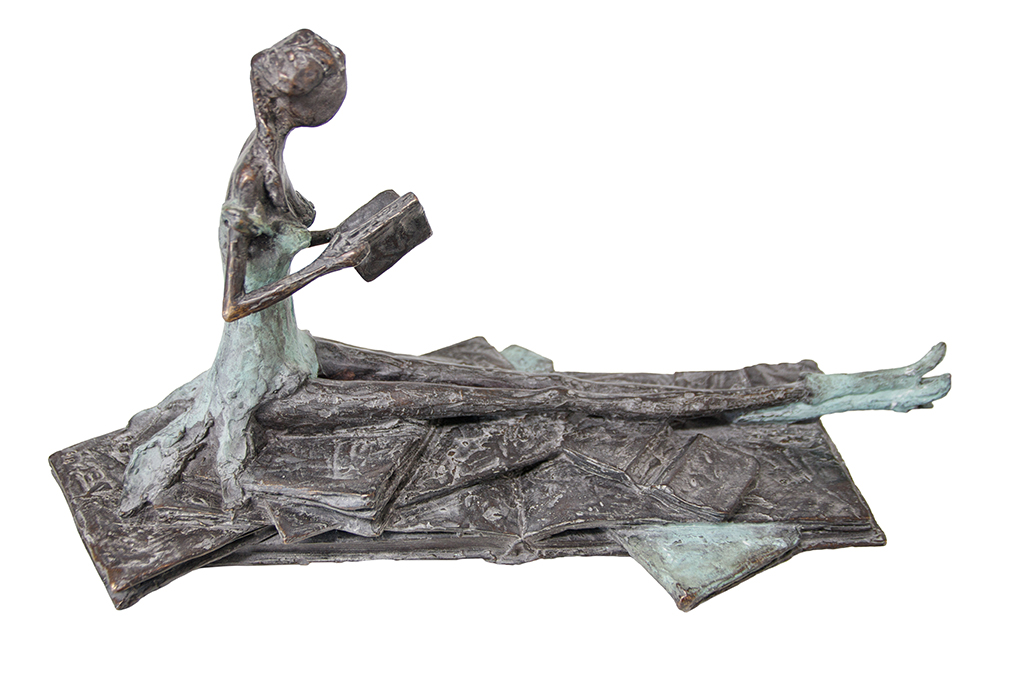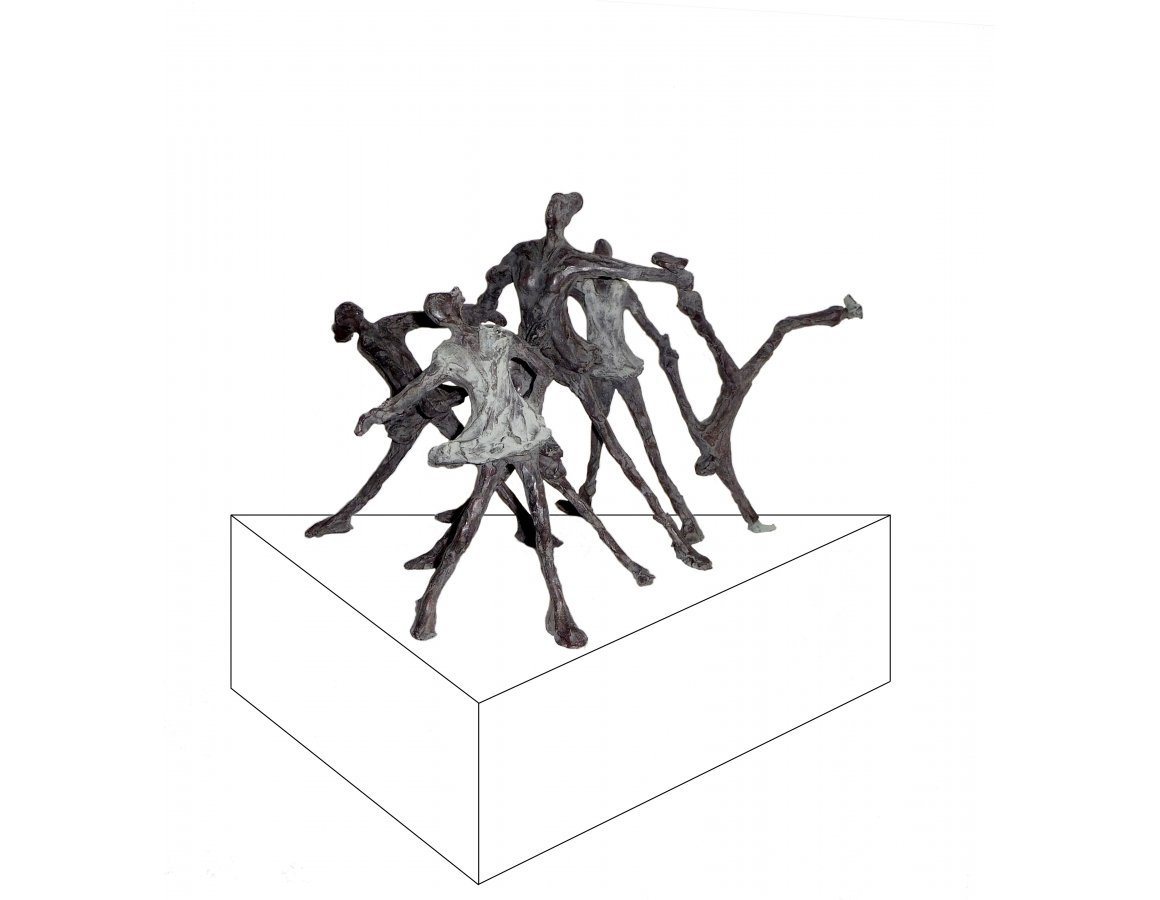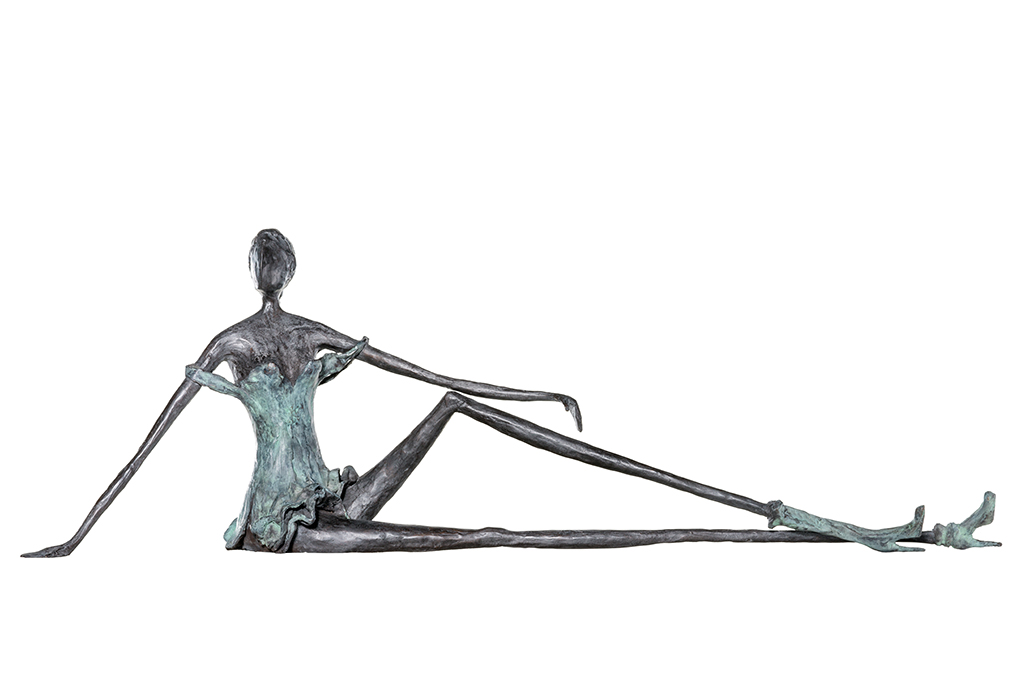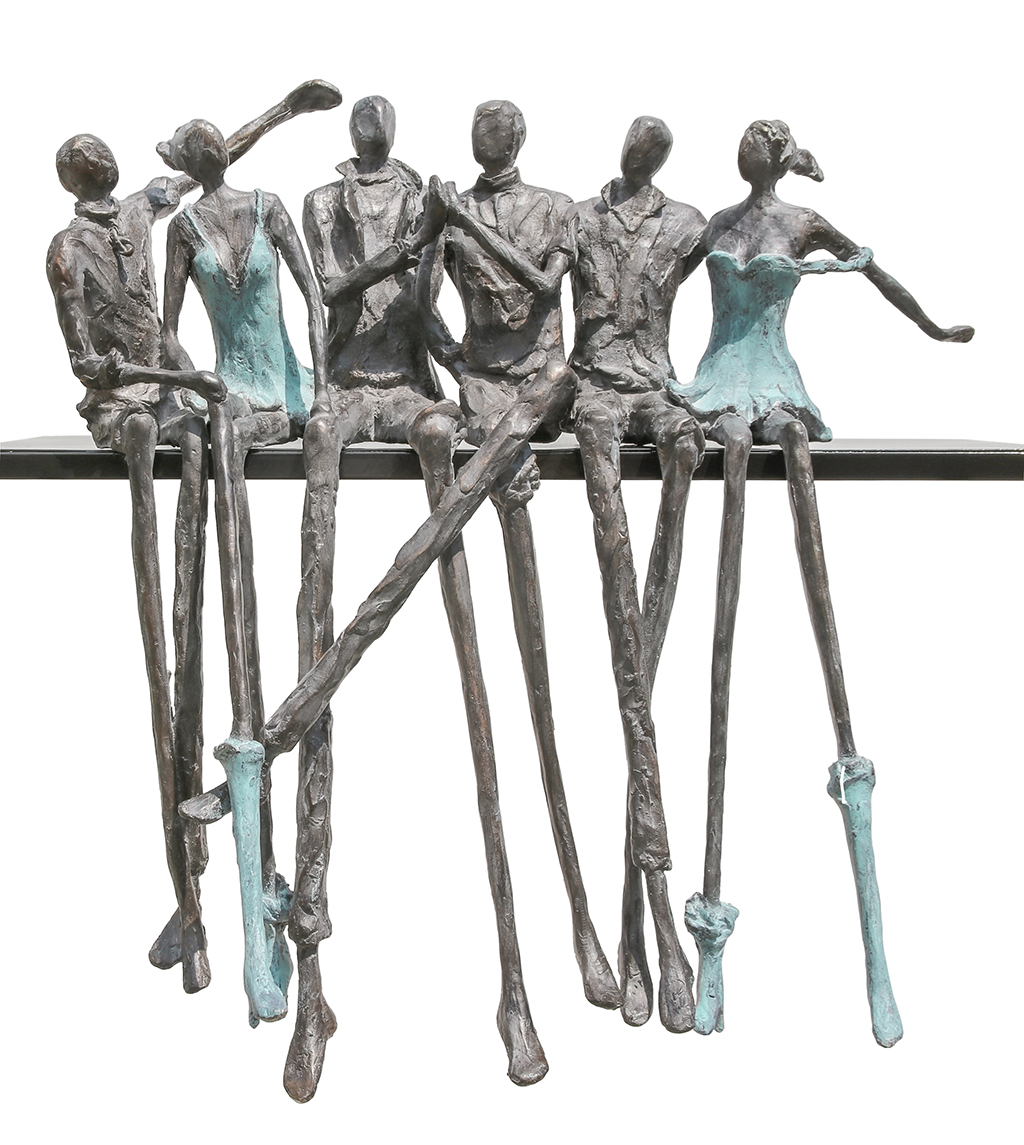Sculpture Art
Sculptures depicting a particular outlook on life
‘Hello Sunshine’ is the title of a sculpture of a woman wearing a summer dress, with sunglasses that are just a little too large brazenly perched on her nose. ‘Booked’ is the title of another, more recent work. It depicts a woman in a nice dress and boots, sitting on a large pile of books. She has one book in her hand and is reading. Both these works are typical of the sculpture art produced by Astrid Huisman-Biemans. These are commonly figures of elegant women with long legs, often going about their daily business – reading, walking, or sitting quietly in the sun for a while. What they are doing reflects their character. They can be high-spirited or perhaps introspective. But what they all have in common is that they are enjoying that moment in time and life in general, and that they seem to be quietly pausing for a moment before moving on. They radiate resilience. And energy. These are sculptures that anyone would enjoy having around them. They become a striking highlight in any interior space and provide a resting point when positioned outdoors.
What makes Huisman-Biemans’ sculpture art so special is the way she combines her artistic vision with little stories relating to the characters depicted. Each figure is solid in structure, with the composition anchored by a special play of lines created by the arms and legs. A whole host of details allow the story to unfold. What would the character depicted in ‘Booked’ actually be reading? Who is the woman portrayed in ‘Hello Sunshine’ waiting for? The questions are partly answered by the nuances contained in the sculpture: a gesture made by the character, the woman’s carefully styled hairdo, or the matt sheen of the bare back of the woman reading. There is something moving about the material used – you just want to reach out and touch the woman’s back.
Story and motion: a moment in time
It is worth examining where the particular strength of Huisman-Biemans’ sculpture art lies. First and foremost, of course, it is in the story a figure tells, but important too are the well-balanced construction and composition of the sculpture. What give structure to the narrative and show the professionalism of the artist are abstract elements – the long legs, for example, which on the one hand have meaning (they represent progress and energy, carry the body and suggest a zest for life and continuity) and at the same time support the composition and the three-dimensional effect of the sculpture. The other details and attributes are also fitted into this abstract framework – the sunglasses of the waiting character, the large, fashionable bag of the woman out walking, the boots worn by another figure, the sock that has fallen down. These not only make the characters look frivolous and human but also contrast nicely with the framework of Huisman-Biemans’ sculpture art.
Just as the long lines in one sculpture enhance the narrative, in other figures they provide an impetus to the motion the artist is suggesting in her sculpture art. It’s about more than just a walk. When Huisman-Biemans brings several people together in one image, they connect with each other. An example is ‘Dearness’, in which three men and two women (siblings) are embracing each other in a display of close contact. Another work in which this comes more strongly to the fore is ‘Hold together’, in which a group of tumbling men and women balance each other out. Given the motion and tension in these figures, it is no surprise that Huisman-Biemans also makes sculptures of people cycling. A recent work, ‘Let’s go for a ride’, shows a couple on a tandem, and for ‘In stitches’, the artist has even fashioned a car in bronze. The characters are playing in and on the car, laughing and joking and having the time of their lives. In each of her sculptures, Huisman-Biemans captures one extraordinary moment, and it is this that creates the illusion of movement. You can’t help but imagine what happens next.
With an emphasis on stillness and motion, introspection and a zest for life, there are several sources of inspiration to be identified. Firstly, Western modern art, which began explicitly engaging with movement in the early 1920s. An example is Marcel Duchamp’s famous painting of a woman descending a staircase. Another possible source of inspiration is Japanese culture. Without claiming that Huisman-Biemans has studied Zen in any great detail, elements of the Japanese philosophy of life, which juxtaposes temporary beauty with eternity, can be discerned in her work. An acceptance of life and the will to go on are the central tenets.
Bronze
Essentially, the sculpture art produced by Astrid Huisman-Biemans is modern art. The materials she works with, on the other hand, are traditional. The artist opts for bronze, a strong and durable material that is ideal for any space. When positioned in an interior, it contrasts pleasingly with soft and natural materials, such as the fabrics and wood used in furniture and floors. A sculpture located in a garden or courtyard becomes a meeting point, or a location at which to pause for a moment.
It should be noted that, as far as the artist is concerned, the way in which the material can be fashioned is actually more important. Then it’s all about the detailing.
Huisman-Biemans brings every detail to life through playing with the patination of her bronze sculptures. Her sculpture artworks generally have a dark, matt patina. The details of garments and attributes, the high-heeled shoes and boots, the flared skirts, hair and dresses all have a lighter patina and are light green in colour with traces of white. The contrast between light and dark enhances the realistic effect of the sculptures. The differences between the dark limbs and torso and the lighter components serve to make small, finer elements more visible.
Other types of work and other materials
While Huisman-Biemans prefers producing bronze sculptures, she does use other techniques too. She produces ink drawings that sometimes resemble preliminary sketches, but are usually artworks in their own right. Her interest in Japan is evident in these drawings too. Sometimes she draws using sumi-e, a traditional Japanese drawing technique that produces highly atmospheric drawings with sharp outlines. She sketches characters and situations confidently and with a wealth of feeling.
While black lines predominate in most of Huisman-Biemans’ drawings, she does employ colour too. This is especially evident in her mixed media work (mixed media on Dibond with Plexiglas). These works are a combination of collage techniques and calligraphy. In her inimitable style, Huisman-Biemans depicts situations full of cheerful, agile characters. The works exude energy and a zest for life.
Finally, her sculptures in colour are three-dimensional versions of these drawings. You could also describe them as colourful companion pieces to her bronze sculptures. Using resin as a base, Huisman-Biemans fashions these collages from paint and paper. In her bronze sculptures, the artist treats the skin and uses patination to give greater expression to details. In these mixed technique works, details are made to stand out through the use of colour.
Commissioned work
Astrid Huisman-Biemans also makes bespoke sculptures, incorporating the client’s own personal stories into them. Commissioned works are also carefully designed to fit well into the environment in which they will stand. All in all, this is a very special process that can result in an unforgettable work of art for your home or office.
